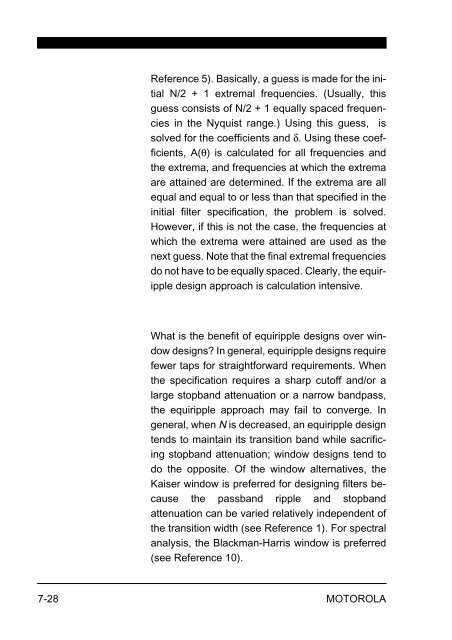Implementing IIR/FIR Filters
Implementing IIR/FIR Filters
Implementing IIR/FIR Filters
Create successful ePaper yourself
Turn your PDF publications into a flip-book with our unique Google optimized e-Paper software.
Reference 5). Basically, a guess is made for the initial<br />
N/2 + 1 extremal frequencies. (Usually, this<br />
guess consists of N/2 + 1 equally spaced frequencies<br />
in the Nyquist range.) Using this guess, is<br />
solved for the coefficients and δ. Using these coefficients,<br />
A(θ) is calculated for all frequencies and<br />
the extrema, and frequencies at which the extrema<br />
are attained are determined. If the extrema are all<br />
equal and equal to or less than that specified in the<br />
initial filter specification, the problem is solved.<br />
However, if this is not the case, the frequencies at<br />
which the extrema were attained are used as the<br />
next guess. Note that the final extremal frequencies<br />
do not have to be equally spaced. Clearly, the equiripple<br />
design approach is calculation intensive.<br />
What is the benefit of equiripple designs over window<br />
designs? In general, equiripple designs require<br />
fewer taps for straightforward requirements. When<br />
the specification requires a sharp cutoff and/or a<br />
large stopband attenuation or a narrow bandpass,<br />
the equiripple approach may fail to converge. In<br />
general, when N is decreased, an equiripple design<br />
tends to maintain its transition band while sacrificing<br />
stopband attenuation; window designs tend to<br />
do the opposite. Of the window alternatives, the<br />
Kaiser window is preferred for designing filters because<br />
the passband ripple and stopband<br />
attenuation can be varied relatively independent of<br />
the transition width (see Reference 1). For spectral<br />
analysis, the Blackman-Harris window is preferred<br />
(see Reference 10).<br />
7-28 MOTOROLA
















